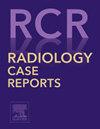婴儿腹部肿块的罕见表现:胎中胎1例报告
Q4 Medicine
引用次数: 0
摘要
由于胎中胎儿(FIF)的罕见存在,全世界每50万活产婴儿中有一例发生,胚胎学上的特征是双胎、单绒毛膜、同卵双胞胎在双胞胎体内部分发育。我们报告一例10个月大的女性,患有逐渐增加的腹胀和不移动的腹部肿块,在对比增强计算机断层扫描(CECT)上突出显示,包括软组织,气体和液体成分。手术干预后,这是一个发育迟缓的胎儿,其特征是存在结构,如耳廓、眼印、肢体、脊柱、大脑和胃肠道组织。这些发现表明存在胎中胎的情况。腹胀的婴儿和幼儿必须将胎中胎儿作为鉴别诊断。这种表现绝不能被忽视,并在临床和放射学上进行探讨,随后进行手术干预,以减轻对脏器和腹部的压力影响。本文章由计算机程序翻译,如有差异,请以英文原文为准。
An uncommon presentation of abdominal mass in an infant: A case report of fetus in fetu
Owing to the rare existence of fetus in fetu (FIF) with an incidence of one per 500,000 live births worldwide, embryologically it is characterized as diamniotic, monochorionic, monozygotic twins partially developing within the twin body. We present a case of a 10-month-old female suffering from progressively increasing abdominal distention and an immobile abdominal mass which was highlighted on contrast-enhanced computed tomography (CECT) consisting of soft tissue, gaseous, and fluid components. It was deciphered after surgical intervention as a stunted fetus characterized by the presence of structures such as the auricle, eye impressions, limb, vertebral column, brain, and gastrointestinal tissue. Such findings suggest the case of a fetus in fetu. Fetus in fetu must be considered as a differential diagnosis among infants and young children presenting with abdominal distention. Such a presentation must never be overlooked and probed clinically and radiologically, followed by surgical intervention to relieve the pressure effect over the viscera and abdomen.
求助全文
通过发布文献求助,成功后即可免费获取论文全文。
去求助
来源期刊

Radiology Case Reports
Medicine-Radiology, Nuclear Medicine and Imaging
CiteScore
1.10
自引率
0.00%
发文量
1074
审稿时长
30 days
期刊介绍:
The content of this journal is exclusively case reports that feature diagnostic imaging. Categories in which case reports can be placed include the musculoskeletal system, spine, central nervous system, head and neck, cardiovascular, chest, gastrointestinal, genitourinary, multisystem, pediatric, emergency, women''s imaging, oncologic, normal variants, medical devices, foreign bodies, interventional radiology, nuclear medicine, molecular imaging, ultrasonography, imaging artifacts, forensic, anthropological, and medical-legal. Articles must be well-documented and include a review of the appropriate literature.
 求助内容:
求助内容: 应助结果提醒方式:
应助结果提醒方式:


